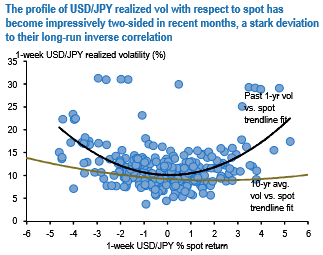The strong Japanese IP report and business survey suggest solid momentum carried over into this year.
But, consumption appears to have been weak at the end of 2016, while the labor market looks favorable.
BoJ stayed on hold as widely expected; autopilot likely will continue at least until H2 of this year.
Abe would visit Trump next Friday, likely will try to persuade him that Japan is not a currency manipulator.
Aside from currencies buffeted by idiosyncratic factors (TRY, MXN, GBP), yen is the only other USD-major where owning vega has been profitable YTD. This owes primarily to USDJPY’s pronounced sensitivity to high frequency shifts in the US policy narrative since the November elections, both on the upside during phases of optimism around a muscular fiscal package and the attendant rise in Treasury yields, as well as on the downside when anxiety mounted around the Trump administration’s trade, tax and FX policy.
The latter does not surprise as yen appreciation and higher volatility during risk aversion is almost an axiom in currency markets; it is on the weaker yen side of the spot distribution that a new, higher volatility dynamic has emerged as US bond markets tantalizingly flirt with the prospect of breaking out of the post-GFC rate repression shackles.
There is also a flow angle to the story, in that perceptible leveraged macro-interest to position for USDJPY upside via options as a positive carry alternative to selling Treasuries has tended to generate a demand/ supply imbalance in the option market, which risks worsening if/when spot rallies towards 120 and prompts dealer demand for vega hedges against extant Japanese importer structures (e.g. knock-out forwards with barriers in the 125-130 zone).
The net result is a two-sided USDJPY realized volatility profile (refer above chart) that has proven relatively impervious to the direction of spot moves in recent months –unlike for most risk-sensitive currency pairs where spot vol correlation is well entrenched and has a distinct bias in favor of dollar strength – and is likely to persist as policy uncertainty in the US shows few signs of abating any time soon.



 Fed Officials Split as Powell Weighs December Interest Rate Cut
Fed Officials Split as Powell Weighs December Interest Rate Cut  U.S. Black Friday Online Spending Surges to $8.6 Billion, Boosted by Mobile Shoppers
U.S. Black Friday Online Spending Surges to $8.6 Billion, Boosted by Mobile Shoppers  Morgan Stanley Boosts Nvidia and Broadcom Targets as AI Demand Surges
Morgan Stanley Boosts Nvidia and Broadcom Targets as AI Demand Surges  Kazakhstan Central Bank Holds Interest Rate at 18% as Inflation Pressures Persist
Kazakhstan Central Bank Holds Interest Rate at 18% as Inflation Pressures Persist  Bitcoin Defies Gravity Above $93K Despite Missing Retail FOMO – ETF Inflows Return & Whales Accumulate: Buy the Dip to $100K
Bitcoin Defies Gravity Above $93K Despite Missing Retail FOMO – ETF Inflows Return & Whales Accumulate: Buy the Dip to $100K  U.S. Productivity Growth Widens Lead Over Other Advanced Economies, Says Goldman Sachs
U.S. Productivity Growth Widens Lead Over Other Advanced Economies, Says Goldman Sachs  Indonesia Aims to Strengthen Rupiah as Central Bank Targets 16,400–16,500 Level
Indonesia Aims to Strengthen Rupiah as Central Bank Targets 16,400–16,500 Level  BOJ Governor Ueda Meets Key Ministers as Markets Eye Policy Shifts Under New Leadership
BOJ Governor Ueda Meets Key Ministers as Markets Eye Policy Shifts Under New Leadership  BOJ’s Noguchi Calls for Cautious, Gradual Interest Rate Hikes to Sustain Inflation Goals
BOJ’s Noguchi Calls for Cautious, Gradual Interest Rate Hikes to Sustain Inflation Goals  Brazil Central Bank Plans $2 Billion Dollar Auctions to Support FX Liquidity
Brazil Central Bank Plans $2 Billion Dollar Auctions to Support FX Liquidity 




























